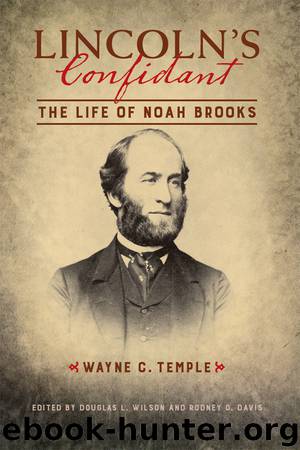Lincoln's Confidant by Temple Wayne C.; Davis Rodney O.; Wilson Douglas L

Author:Temple, Wayne C.; Davis, Rodney O.; Wilson, Douglas L.
Language: eng
Format: epub
Publisher: University of Illinois Press
Returns to Journalism
The ex–naval officer returned to the field of journalism where he became known as a versatile writer and a prominent California editor.80 “A large daily newspaper, radical Union in politics, with a capital of $150,000” was being organized, said Brooks, “when the news of my removal (Aug. 24) came out.” The publishers were having difficulty finding a man to put in the editor's chair, but when Brooks's removal came “like a special providence,” they appointed him managing editor.81 The name of the new Republican organ was the San Francisco Daily Times. As early as July 12, 1866, both the Alta California and the Bulletin of San Francisco announced that a new daily newspaper was being organized; however, it was not until the latter part of October that the name was disclosed.82 Even before its first issue, the policy of the Daily Times was disclosed by a paper which Brooks had formerly edited. “The Times,” said the Marysville Appeal, “will assume and maintain a fearless stand on the side of the Union…. The Radical Union men hope to have in the Times an organ which will give forth no uncertain sound; doubtless the loyal community will not be disappointed.”83 The publisher of the new San Francisco daily newspaper was the Times Publishing Company, located at 336 Montgomery Street, but Brooks established his office at 521 Clay Street where he employed his nephew, Frank Upham, to aid him with the work.84
Before the Times was ready to begin publishing, Brooks returned to Marysville, California, to participate in the sixth annual program of the Northern District Fair. At 8 P.M. on September 6, 1866, the president of the association introduced Brooks, who then read an original poem of his to the crowd assembled at the Pavilion on the fair grounds.85 The title of the composition was “The Transition,” and it was later published by the Northern District Agricultural Society.86 The style of the poem closely resembles Oliver Goldsmith's “The Deserted Village.”
After weeks of planning, the Times issued its first number on November 5, 1866. It was a morning paper which went to press every day with the exception of Sunday; in addition, there was an evening edition for northern California and also a weekly edition. Under Brooks's supervision was an able staff of reporters and contributors who made the Times “a paper of high literary standing.”87 Among the correspondents was Petroleum V. Nasby, and in the editorial rooms were William Bausman and N. S. Treadwell, while O. B. Turrell served as foreman of the typesetters. The nominal editor-in-chief was James McClatchy, but Brooks managed the paper and served as chief editorial writer, with a salary of about fifty dollars a week.88 One paper declared that his editorials were “dignified and decorous,” but was of the opinion that the types were “a little flashy,” though the flashiness probably would “wear off in the contemporary friction” to which they would be subjected.89 The Times itself admitted that it would have a difficult time in San Francisco since there were eleven newspapers in the city.
Download
This site does not store any files on its server. We only index and link to content provided by other sites. Please contact the content providers to delete copyright contents if any and email us, we'll remove relevant links or contents immediately.
| Afghan & Iraq Wars | American Civil War |
| American Revolution | Vietnam War |
| World War I | World War II |
Waking Up in Heaven: A True Story of Brokenness, Heaven, and Life Again by McVea Crystal & Tresniowski Alex(37501)
Empire of the Sikhs by Patwant Singh(22778)
We're Going to Need More Wine by Gabrielle Union(18649)
Hans Sturm: A Soldier's Odyssey on the Eastern Front by Gordon Williamson(18334)
Leonardo da Vinci by Walter Isaacson(12821)
The Radium Girls by Kate Moore(11642)
Tools of Titans by Timothy Ferriss(7833)
Educated by Tara Westover(7700)
How to Be a Bawse: A Guide to Conquering Life by Lilly Singh(7167)
Permanent Record by Edward Snowden(5553)
The Last Black Unicorn by Tiffany Haddish(5428)
The Rise and Fall of Senator Joe McCarthy by James Cross Giblin(5152)
Promise Me, Dad by Joe Biden(4916)
The Wind in My Hair by Masih Alinejad(4853)
The Crown by Robert Lacey(4580)
A Higher Loyalty: Truth, Lies, and Leadership by James Comey(4568)
The Iron Duke by The Iron Duke(4130)
Joan of Arc by Mary Gordon(3801)
Stalin by Stephen Kotkin(3732)
